Abstract
Regarding the production of leafy vegetables, especially lettuce, in Japanese agriculture, based on data from 2022, the national harvest volume was 553kt, the cultivated area was 19.9kha, and Nagano recorded the highest shipping volume of 175kt. The trends and characteristics that can be inferred from these figures are: First, the large harvest yield figures indicate the high demand for lettuce in Japan. The area under cultivation is also expanding, suggesting that a production system that meets demand is being established. In particular, Nagano is the top shipping area, so it is possible that cultivation there is thriving. Additionally, because lettuce is consumed in large quantities, this suggests that it is actively distributed throughout the country from production areas. These data indicate the importance of leafy vegetables in Japanese agriculture and that an efficient production and distribution system has been established.
Lettuce yield (main data).
Looking at data from 1973 to 2022, Japan’s lettuce harvest has fluctuated but hit a historic peak of 586kt in 2016. After that, the yield dropped to 94.4% of its peak. There are several possible reasons behind this decline. First, agricultural mechanization and technological innovation have increased production efficiency but may have also increased production costs. It is also possible that urbanization has led to a decrease in agricultural land, affecting the area under production. Additionally, changes in food culture and consumer preferences may have also affected yields. For example, the demand for lettuce has decreased as the demand for other vegetables and processed foods has increased. Although these factors are likely to have caused harvest volumes to decline from their peak, lettuce remains an essential vegetable on the Japanese diet, suggesting that demand remains stable.
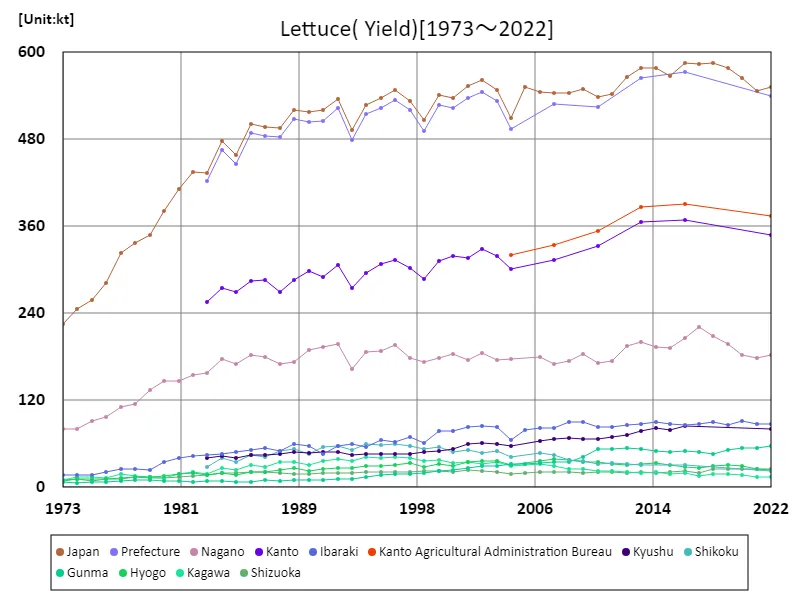

The maximum is 586kt[2016] of Japan, and the current value is about 94.4%
Lettuce harvest volume (by prefecture).
Looking at the data for leafy vegetable harvests in Japan in 2022, the largest overall was Nagano at 183kt, which is the current maximum figure. There are several characteristics and trends that can be inferred from this data. First, it suggests that Nagano is a major producer of leafy vegetables nationwide. Nagano is blessed with favorable geographical conditions and a favorable climate, and may have an environment suitable for growing leafy stem vegetables. Additionally, since Nagano’s harvest yields are exceeding past data, it is possible that the region’s agricultural techniques and production systems are improving. Furthermore, by comparing the data with those of other prefectures, it will become clear whether there are regional production biases and regional characteristics. Analyzing such data will enable us to understand regional differences and trends in leafy vegetable production in Japan, and to formulate effective agricultural policies and production management guidelines.
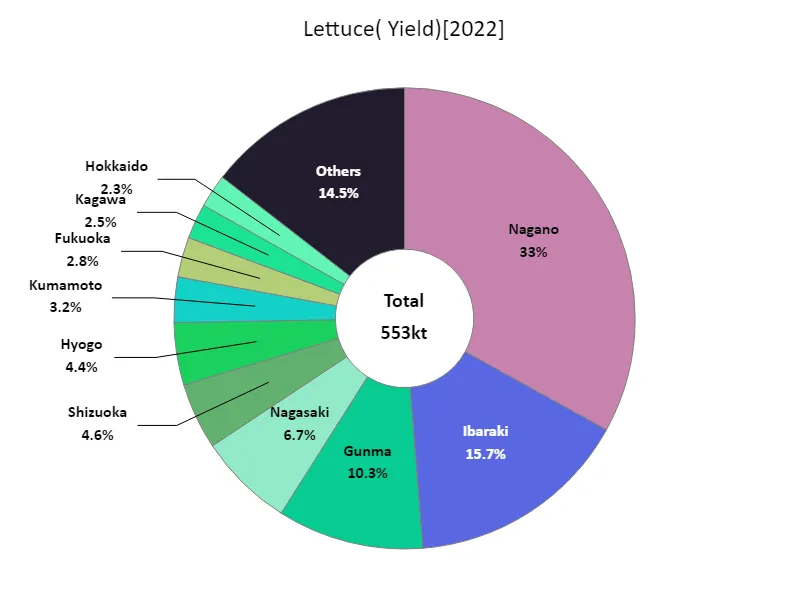

The maximum is 183kt of Nagano, the average is 11.8kt, and the total is 553kt
Lettuce cultivation area (main data).
Looking at data from 1973 to 2022, the area of land cultivated with lettuce in Japan has fluctuated, but hit a historic peak of 23 kha in 1991. Since then, the area under cultivation has fallen to 86.5% of its peak. There are several possible reasons behind this decline. First, structural changes in agriculture and technological innovations may have led to a shift to other crops and agricultural products. Additionally, the conversion of agricultural land to residential and industrial use as a result of increasing urbanization may have also contributed to the decrease in cultivated area. Furthermore, it is possible that the reduction in area was caused by a shortage of agricultural labor and rationalization of management. Changing consumer eating habits and an increase in competing foreign products are also cited as factors contributing to the decline in cultivated area. It is believed that a combination of these factors has resulted in a decline in the area planted since its peak, but lettuce still occupies an important place on the Japanese dinner table, suggesting that demand is stable.
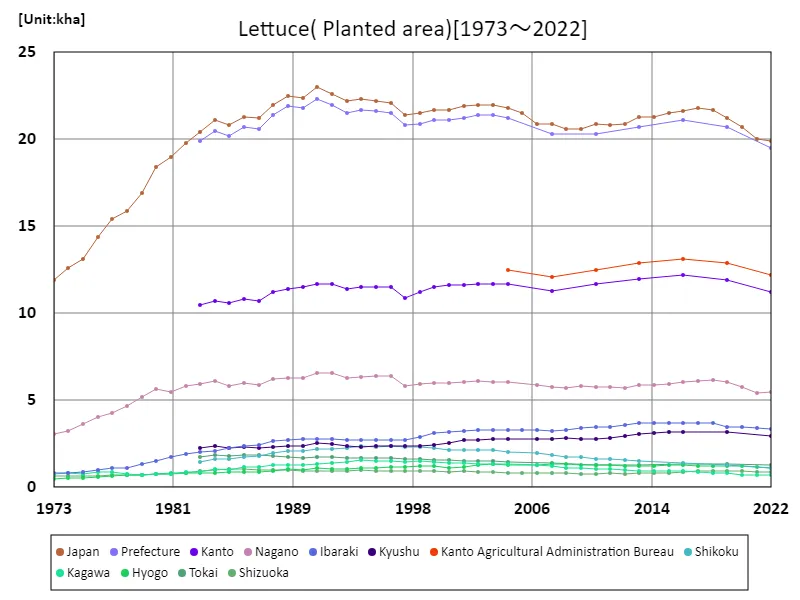

The maximum is 23kha[1991] of Japan, and the current value is about 86.5%
Lettuce cultivation area (by prefecture).
Looking at the data on the area of cultivated leafy vegetables in Japan for 2022, the largest overall is Nagano at 5.5kha, which is the current maximum value. There are several characteristics and trends that can be inferred from this data. First, it suggests that Nagano is a major producer of leafy vegetables nationwide. Nagano is blessed with favorable geographical conditions and a favorable climate, and may have an environment suitable for growing leafy stem vegetables. In addition, since the cultivated area in Nagano exceeds past data, it is possible that the region’s agricultural techniques and production systems are improving. Furthermore, by comparing the data with those of other prefectures, it will become clear whether there are regional production biases and regional characteristics. Analyzing such data will enable us to understand regional differences and trends in leafy vegetable production in Japan, and to formulate effective agricultural policies and production management guidelines.
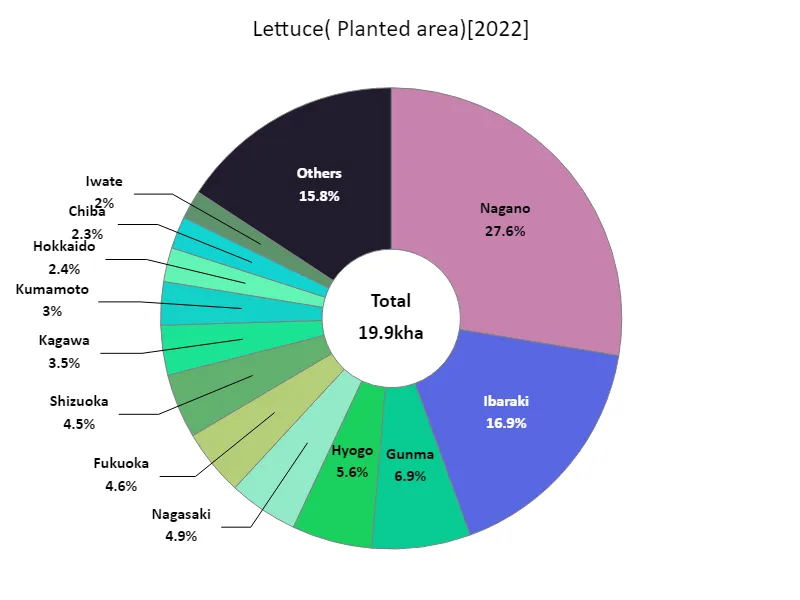

The maximum is 5.5kha of Nagano, the average is 424ha, and the total is 19.9kha
Lettuce shipment volume.
Several characteristics and trends can be seen in the 2022 lettuce shipping volume data for Japan. First, the largest overall shipment volume was from Nagano at 175kt, accounting for about one-third of the total shipment volume. This shows that Nagano is a major lettuce producing area. Additionally, the average shipping volume was 11.1kt, indicating that individual regions are actively shipping lettuce, albeit on a relatively small scale. Furthermore, the total shipping volume of 520kt shows that lettuce is in wide demand and produced in large quantities within Japan. This indicates that lettuce is common on the Japanese diet and consumption is relatively high. It also appears that lettuce is being actively produced in areas other than Nagano as well. Through such data, the importance and widespread use of leafy vegetables, especially lettuce, in Japanese agriculture is confirmed.
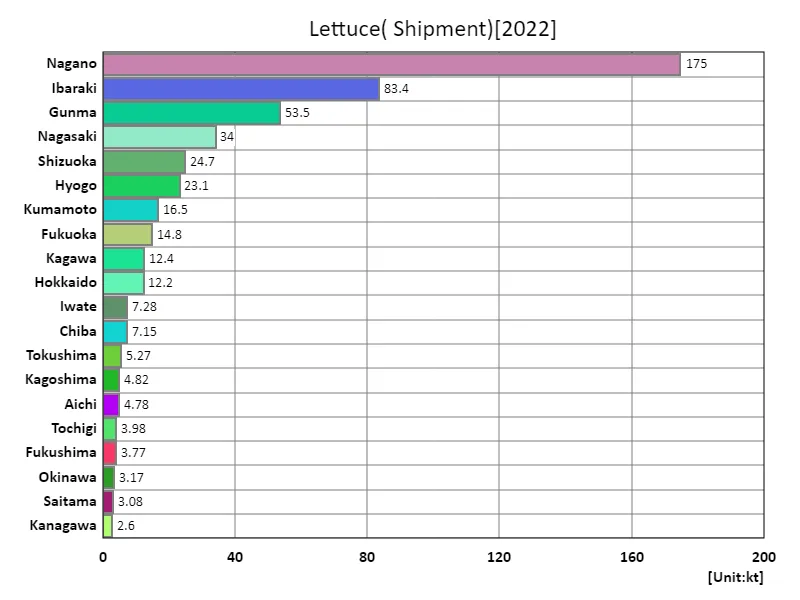

The maximum is 175kt of Nagano, the average is 11.1kt, and the total is 520kt
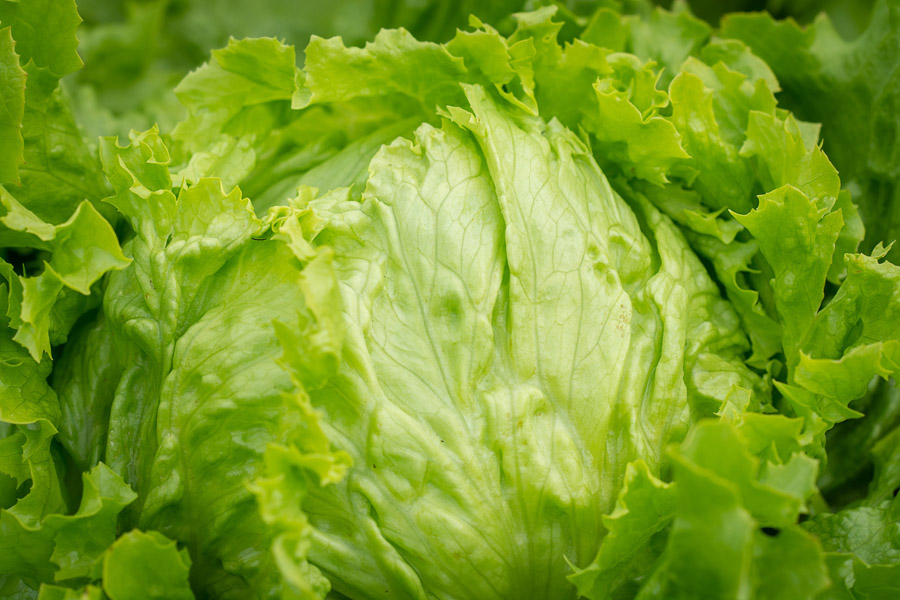


Comments